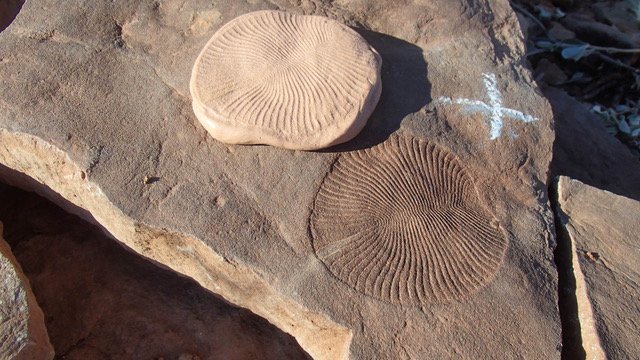Written byAaron GronstalSource
NASA Astrobiology

Oct. 7, 2019
Research Highlight
Redox in the Rise and Fall of the Ediacara Biota

Dickinsonia costata, one of the most common species of the Ediacaran period.Image credit: Mary Droser.
Researchers have uncovered new details about oxygen (O2) levels at a point in Earth’s history during the evolution of early animals.
The study centers around the Ediacara biota, a term that refers to a collection of complex, multicellular eukaryotic organisms that lived on the Earth during the Ediacaran period (635 to 541 million years ago (Ma)), which was the final period of the Proterozoic eon. The Ediacara biota originated at some point in the middle Ediacaran Period and survived until the Cambrian period (the first period of the Palaeozoic eon). Throughout this time on Earth, there were marked increases and decreases in abundance of and diversity within the Ediacara biota.
Based on fossils of Ediacara biota, it is thought that diversification of these organisms happened either during or shortly after an event known as the ‘Ediacaran Shuram negative C-isototope Excursion (SE). Previously, it has been suggested that the SE coincided with an increase of oxygen in Earth’s oceans. However, studies have provided conflicting evidence concerning the extent of ocean oxygenation at this time.
The new study aims to resolve the debate surrounding oxygen levels during the SE by studying variations of uranium isotopes in the rock record from three locations: South China, Siberia, and the United States of America. The results are similar for all three sites, and show the “largest positive shift in δ238U ever reported in the geologic record.” This data alongside quantitative modeling suggests that, during the SE, the global ocean switched from being in an anoxic state to an oxygenated state that was similar to the levels we see today. The authors of the new study believe that this work, when taken in context alongside other studies, shows that global marine redox was a key driver in the “rise and fall of the Ediacara biota.”
The study, “Global marine redox changes drove the rise and fall of the Ediacara biota,” was published in the journal Geobiology. The work was supported by NASA Astrobiology through the Exobiology Program. This newly-revealed science is also a critical part of NASA’s work to understand the Universe, advance human exploration, and inspire the next generation. As NASA’s Artemis program moves forward with human exploration of the Moon, the search for life on other worlds remains a top priority for the agency.